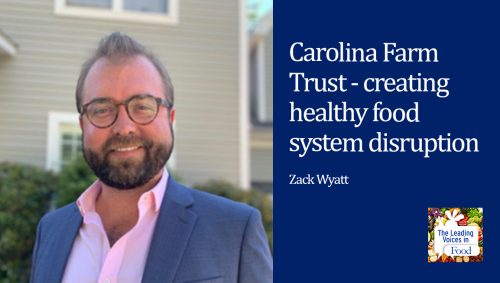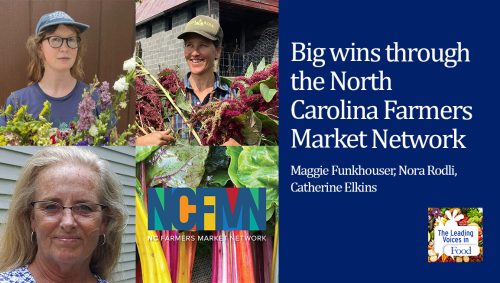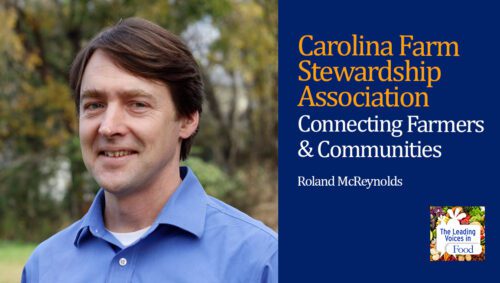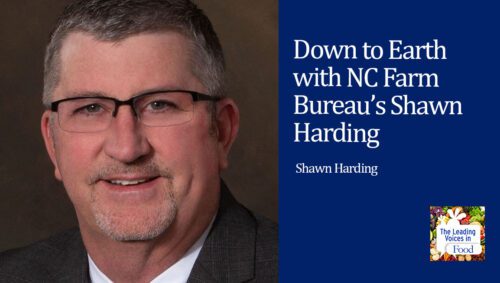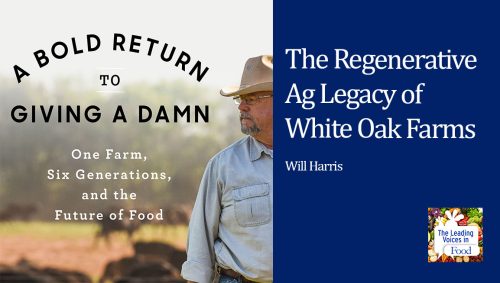The Leading Voices in Food
E54: Farming with Hurricanes in the Blacklands of North Carolina
At Middlecreek Farms, hurricanes shape the way Dawson Pugh farms his land. His property lies just two feet above sea level, and managing water is his biggest challenge.
Subscribe: Apple Podcasts | TuneIN | Google Podcasts | SoundCloud | PocketCasts | Radio Public
Tags: Agriculture & Tech | North Carolina | Voice of Farming |

Dawson Pugh from Engelhard, North Carolina farms Middlecreek Farm with his wife Bethany and four kids.
Welcome to the Leading Voices in Food Podcast, an educational series produced by the World Food Policy Center at Duke University. I’m Deborah Hill. You’re listening to a segment in our Voice Of Farming series.
We are about a half a mile from the Pamlico Sound, so the only thing between us and Cape Patterson is water. We can climb through the top of our grain elevator and see shrimp boats in the sound.
I’ve always heard the saying that dry weather will scare you to death and wet weather will kill you. Here, our crops are hurt by too much water many more times than dry weather.
I’m Dawson Pugh from Engelhard, North Carolina. My wife Bethany and I have four kids and we own and operate Middle Creek Farm.
Eastern North Carolina is hit by hurricanes more than anywhere else in the country. And right here where our farm is just, we’re about 18 inches to two foot above sea level. Whenever a hurricane comes a lot of times we have salt water flooding during the storm and in the last, I don’t know, five or six years it seems like we’ve had a lot more than normal.
Most usually hope for, or every time we hope for, a good soaking rain ahead of the storm so if we do get some flooding that the salt water won’t soak into the land. But, salt water intrusion is something that we deal with all the time. Just here in Florence we had probably two-thirds of our farm land was covered with tide water from the hurricane, salt water, ocean water so it’s really salt.
And we didn’t get much rain. We were really worried that it was really going to have an effect on our farm land for this year. But the good thing is we had a really wet winter where you know, most people were probably not wanting all the rain that we got last winter, but I was really glad to see it. It helped flush a lot of the salt water out of our soil and we hadn’t really seen a lot of damage other than places that we had been seeing it before.
This area is called the Blacklands and because of our high organic soils, our soil is blacker. A really productive soil but it is flat soil, hard to drain so we’ve got ditches and drainage systems that we have to have in place to be able to farm it.
We own about 4,200 acres and we grow corn, soybeans, both of those. Corn for grain used for animal feed here in the state. Soybeans used some for seed but most for soybean meal for the animals, livestock industry.
Then we grow fresh market red potatoes, red and yellow potatoes that we bag. We’re a partner in Pamlico Shores. It’s the name of our business that would do potatoes and we pack those potatoes that go straight to grocery stores or sell to food service. We grow Mattamuskeet sweet onion. We don’t grow many acres but we sell pretty much to, we don’t do any commercial selling. We sell by the bag. And we grow fresh market and processing green beans.
Dawson now farms 4,200 acres of land to cope with the flat topography of the area. Salt water flooding and issues of standing water, his farm land is divided into triangles. Each triangle has been graded to drain water off his crop fields and into an extensive canal system.
I don’t know that there is a normal rain. I think it’s somewhere about 50 to 55 inches is normal. Some years, you know, 75. Not many years are we probably below 50, but we’re affected, I think I said while ago, but more years than not, we’re affected by too much rain.
The big rains are what? Well, you know, you can get a four and five inch rain and the water stands because the land is flat and we’re low and it just takes a while for it to get off. Especially if the land is already saturated and you get a big rain like that. Then we have to pump the water off and it takes a lot of time. In the summertime when it’s hot and you’ve got standing water, then it kills the crops.
All of our land is not pumped. Some of it is naturally drained. Some places that we have, we have stationary pumps that are there all the time. It’s a system. It’s not just a pump, it’s a system. You know, you’ve got your field ditches, then you’ve got your ditches, you’d got a larger ditch that drains those field ditches to a larger canal. There’s a dike around the farm to keep salt water from coming in. You’ve got a pumping station there that pumps the water out and we’ve got pumps that range from 12 inch pump to 36 inch pumps to drain depending on the size of the farm and you know, how much water we have to get off.
We also have portable pumps that are hooked to tractors, and if we’ve got a spot that, you know, we don’t have a pump there that we can go and put that pump in and pump that place out and move it to another one. Or if we have something that goes wrong with one of our stationary pumps, we can use one of those portable pumps or several of those portable pumps to pump it out. If we’ve got all of our portable pumps and stationary pumps running, I think that’s about 15 pumps. We stay busy just tending to pumps when we have an event like that.
You know, we farm some of the oldest farm land in the country right here where we’re farming because this is old land. A lot of the land that we’re farming, you know, a lot of the land in the Blacklands was cleared, but this land has been farmed since the 1700s, some of it. We’ve got something that we need to protect. This might used to be swamp, but it was a swamp a long time ago.
I really believe that when the settlers came to settle the land they were finding the higher land and this probably wasn’t swamp. They just find some fertile soil and started planting it. We’ve lost land to salt water intrusion, some land that I remember being farmed that’s grown up in trees now because just couldn’t grow anything on it. But I remember them talking about places that used to be farmed like 75 years ago, that, you know, I don’t ever remember being farmed because they just quit farming because of that, too.
We see it gaining in some areas. We work all the time to try to prevent salt. We’ve got tide gates that we use to keep the salt water from coming in the ditches, but allows the freshwater to go out of the fields. I don’t even have a number on how many of those we have, but when we get a rain event, you know, that’s something that somebody stays busy just making sure that there’s no trash hung in them.
We’ve been fighting salt for, I mean, my daddy said that his granddaddy dealt with it, so it’s nothing new, it just seems like maybe getting a little bit worse or maybe we’re paying more attention to it. I’m not sure. But I know that the flooding that we’ve had from the hurricanes seems like we’re getting more of that. That’s affecting it in some places also.
The reason that we want a good rain ahead of the hurricane or ahead of the tidewater is because the soil can soak the freshwater in and it can be saturated when the salt water comes over the land and it wouldn’t allow the salt water to soak into the land.
We’ve got some places that we are trying to recover. I’ve taken out of production and letting some natural grasses grow that, you know, where if you plant a crop they might not grow but there’s some natural grasses that will grow. Just let it grow for several years and just test it to see. And also, putting in new structures to help protect that from salt water. Some places that, you know, it’s ongoing. It’s not something that’s in place that we have to maintain. We are always putting in new structures to help keep the salt water right. Maybe build a new dike to keep flooding out of it.
We also try, in places that we can, we try to flood it with fresh water in the winter to push the salt down and use freshwater to do it. It’s a work in progress. We have successfully brought some areas back, but it’s not areas that are so bad they won’t grow anything. It’s the places that you see some effects but you don’t, there’s still a crop growing there, so you can go in there and make it better. I think that the places that are so bad that the crops won’t grow, we probably are making them better, but it just takes a lot more time.
It depends on soil type. If it’s a higher organic blacker soil, the soil doesn’t pack as much as the clay soil does so water can penetrate through it. It’ll allow the water to push the salt out of it, too. There’s a lot of different variables there, but we’re making some headway on some places. Other places we’re losing just because of frequent flooding.
Some things we’ve been thinking about since we’ve had the hurricanes is trying to find some crops that we can harvest before hurricane season. I like to grow vegetable crops and we can get those harvested in the summertime. If we could get, you know, maybe not have as many acres but have crops that we can depend on to pay the bills, where we wouldn’t have to depend on the corn and soy beans as much, we can get harvested in May, June, July, maybe 1st of August. That would mean a lot for us. Then when a hurricane comes and we get flooding, then if we’ve lost some soybeans it won’t matter as much to us.
That’s something we’re kind of working toward. It’s not something that we can do in one year. And knowing that my son, Steven, that wants to come back and farm and possibly, I want to be able if my other kids want to be able to farm, I want to be able to give them that option. I feel like that that might be the direction that we need to head into.

